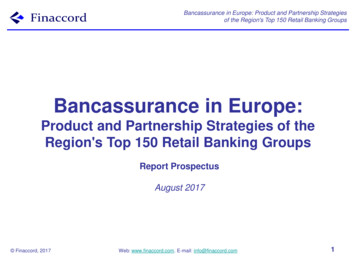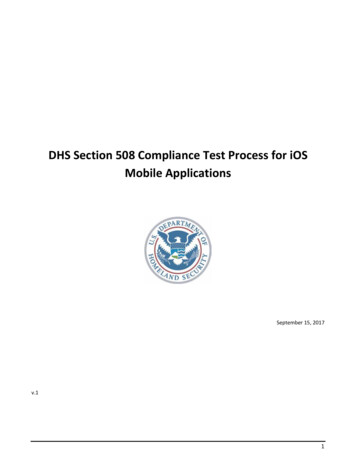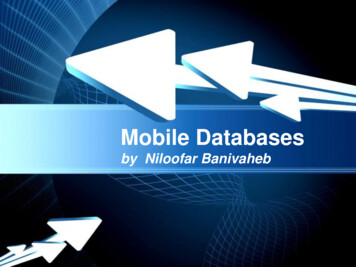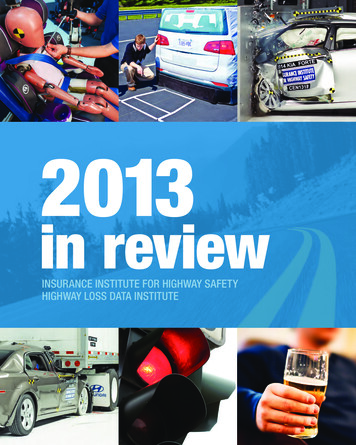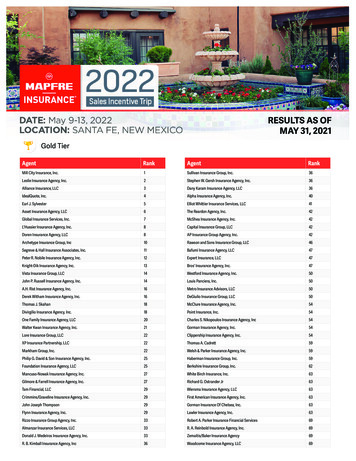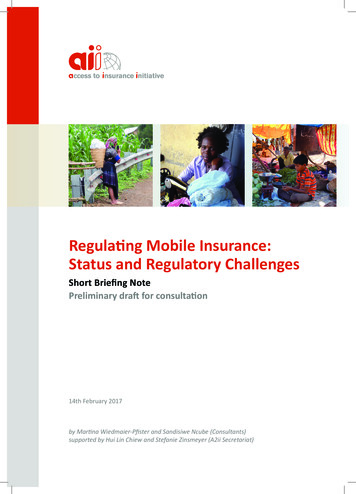
Transcription
Regulating Mobile Insurance:Status and Regulatory ChallengesShort Briefing NotePreliminary draft for consultation14th February 2017by Martina Wiedmaier-Pfister and Sandisiwe Ncube (Consultants)supported by Hui Lin Chiew and Stefanie Zinsmeyer (A2ii Secretariat)1
Overview of study and upcoming IAIS PaperThis document serves as a preliminary summary of a larger study commissioned by the Access toInsurance Initiative (A2ii) for 2017. The summary provides a review of supervisory approaches to mobileinsurance (m-insurance) in various jurisdictions with the aim of providing inputs to the forthcoming IAIS1-A2ii-CIMA2 Conference on Mobile Insurance Workshop in Douala, Cameroon from 23rd- 24th February2017. The study draws on various sources including online surveys, telephone interviews and desktopresearch. Online surveys were completed by insurance supervisors from 26 jurisdictions and follow-upin-depth telephone interviews were conducted with insurance supervisors from 9 jurisdictions betweenOctober 2016 and January 2017 (Brazil, CIMA, Ghana, Kenya, India, Indonesia, Philippines, South Africaand Tanzania). Furthermore, additional interviews were also conducted with key resource persons andstakeholders within the m-insurance sector.This study will also feed into the work of the IAIS Drafting Group on Digital Technology in InclusiveInsurance on an applications paper on digital insurance. The paper focuses on m-insurance, but alsoaddresses some other aspects of digital insurance and technology.1 The International Association of Insurance Supervisors (IAIS) is a voluntary membership organisation of insurance supervisors and regulators from more than 200 jurisdictions in nearly 140 countries. See www.iaisweb.org2 CIMA is the regional insurance regulatory body in West and Central Africa – made up of the following French-speaking countries Benin, Burkina Faso, Cameroon, CentralAfrican Republic, Congo, Côte d’Ivoire, Gabon, Guinea-Bissau, Guinea Equatorial, Mali, Niger, Senegal, Chad, Togo – whose objective is to work towards the establishment of asingle insurance market.2
Table of Contents1.2.3.4.Annex 1Annex 2State of m-insurance: key trends and challengesRisks and issues in m-insurance business2.1 Prudential risks2.2 Conduct of business risksRegulatory approaches and supervisory challenges3.1 How existing regulations apply to m-insurance3.2 Overview of supervisory responses to m-insurance3.3 Key issues to consider in regulating m-insurance3.4 Current and upcoming supervisory approaches3.5 Other complementary measuresConclusion4.1 Understanding the risks and challenges pertaining to m-insurance4.2 Practical measures in addressing m-insurance risks47911141418202223242425Issues and approaches along the inclusive insurance product life cycleReferences2729List of VASVATAccess to Insurance InitiativeAnti-money LaunderingAverage Revenue per UserConsultative Group to Assist the PoorConférence Interafricaine des Marchés d’Assurances(Inter-African Conference on Insurance Markets)Electronic moneyElectronic paymentsDeutsche Gesellschaft für Internationale Zusammenarbeit (GIZ) GmbHGlobal System for Mobile CommunicationsGSM AssociationInternational Association of Insurance SupervisorsInsurance Core PrincipleInternational Finance CorporationInternational Labour OrganizationInformation TechnologyMobile insuranceMicroinsurance NetworkMobile Money ProviderMobile Network OperatorTechnical Service ProviderShort Message ServiceValue Added ServiceValue Added Tax3
1. State of m-insurance: key trends and challengesMobile insurance (m-insurance) has become an attractive business approach to providing simpleinsurance products. Mobile technology can be applied in many ways and by all stakeholders acrossthe insurance value chain (see Box 1). It allows for instant client reach and significant scale, but at afraction of the cost of traditional business models. The entrance of new types of industry players suchas technical service providers (TSPs) has further shaped the evolution of this business model.Box 1 Defining m-insuranceThere is no consensus yet among stakeholders within the insurance sphere concerning the definitionof m-insurance. Interviews and surveys conducted with 26 insurance supervisors revealed differentdefinitions and interpretations of m-insurance or mobile microinsurance.The A2ii-CIMA workshop on m-insurance (16th - 17th May 2016) in Ivory Coast defined it as“A microinsurance product that relies on the mobile phone system and infrastructure to supportfunctions of the insurance process.”For the purpose of this document, the authors define m-insurance as “the use of mobile phonetechnology to perform key activities across the insurance value chain.”Figure 1. Insurance value chainProvision of m-insurance is often facilitated by a more complex value chain that includes non-insuranceplayers. Like other alternative distribution channels typical of inclusive insurance, the provision of m-insuranceis characterised by a lengthier, more complex value chain composed of both conventional and nonconventional stakeholders. Non-conventional stakeholders include non-insurance players such as MobileNetwork Operators3 (MNOs) and m-insurance dedicated Technology Service Providers (TSPs). The roles andactivities of these stakeholders depend on the business model (See Box 2).3 A mobile network operator is defined as “a company which has a government-issued licence to provide telecommunications services through mobile devices,” (GSMA,2016).4
Box 2 Types of m-insurance business models4M-insurance stakeholdersM-insurance business models can involve both conventional insurance stakeholders (an insurer orunderwriter, and insurance intermediaries) and non-conventional insurance stakeholders such asMNOs, Mobile Money Providers (MMPs) and TSPs. The insurer provides the underwriting function and is supervised by the insurance supervisor. The MNO and MMP provide access to the client base, mobile infrastructure, payment systemsand brand presence. Generally, the MMPs are MNO subsidiaries and provide for the transactionplatform for premiums and claims. The TSP provides a range of services such as technology platform, call centre and general processsupport in the insurance value chain ranging from sales, enrolment, policy administration to claimsmanagement.Business models according to key driverM-insurance stakeholders could hold various roles, depending on the type of business model. In the insurer-driven business model, the insurer takes the lead in the partnership by conductingproduct development and overseeing the overall business strategy. The MNO plays a passive role,where it provides MNO infrastructure and data, sometimes supported by the MMP. The role of theMNO or MMP is generally limited to marketing, facilitating airtime deduction, mobile money orcash payments. In the TSP-driven business model, the TSP takes the initiative, in that it initiates dialogue with theinsurance supervisor, approaches the MNO and selects an insurer, identifies the target market andcustomer profile, develops the product, and leads the forming of the partnership. The TSP alsotypically ‘fills the gaps’ in providing expertise and support where needed (including developmentof the platform, back-office processing). In the MNO-driven business model, the MNO drives the initiative. The MNO – generally withinvolvement of a TSP – provides the insurer with its client base, enrols clients and provides thepayment mechanisms. In all models, the MNO provides considerable brand strength in stimulatingtake-up of insurance in order to drive direct revenue and/or adjacent benefits such as increasingaverage revenue per user (ARPU), reducing churn and enhancing their brand5. In the loyaltyapproach, the MNO pays premiums on behalf of its customers who can enrol for basic cover freeof charge.4 A business model is defined as the method or means through which a company captures value from its business and can incorporate the full range of activities fromacross the value chain from product design, marketing and distribution, (IAIS, 2015a).5 A2ii, Report on the CIMA-A2ii Workshop “Regulating m-insurance”, 16th -and 17th May 2016 (A2ii, 2016)5
M-insurance products are evolving from the loyalty approach and simple benefits to paid products anddiverse coverage. Initial m-insurance product offerings were simple life and accident covers. These becameincreasingly diverse, and now include personal accident, agriculture, and health among others, often asbundled risks. The first wave of m-insurance initiatives introduced loyalty models where premiums were paidby the MNOs, but in most instances clients could ‘upgrade’ the cover by paying an additional premium. Asm-insurance markets worldwide mature, it has been found that clients are increasingly converting from loyaltymodels to paid products; in one large scheme in Ghana, 55% of clients migrated from a loyalty product to apaid product (CGAP, 2013). The majority of new m-insurance products require clients to pay the premiumdirectly. In some markets or by some players, loyalty products are slowly being phased out; while in others,MNO very much still drive this model. As such, the business model deployment strategy differs across regions(e.g. the loyalty approach is still common in Asia).There are signs of a potential shift from group policies towards individual or customised policies. Loyaltyproducts are often provided to clients on a group basis with the MNO or TSP being the master policyholder.The underwriter (and other players in the value chain) does not typically engage with the client on anindividual basis. In some markets and with the move towards paid models, providers are increasingly engagingwith clients on an individual level and utilise data analytics to provide customised m-insurance products.Airtime deduction are the most prominent form of payment but are sometimes not permitted by centralbank regulations. There are two predominant forms of premium payment and collection available tom-insurance clients: mobile wallets and airtime deduction. Other payment forms like cash or bank deductionare also available. The GSMA 6found that 63% of premiums collected through MNOs are done through airtimededuction (GSMA, 2016). Interviews and survey responses also confirm the prominence of airtime deductionas a premium payment mechanism across various jurisdictions. One TSP found that airtime deduction has thehighest conversion rate7 (25%) from loyalty to paid products, in comparison with mobile wallet (1%). Centralbank regulations in some jurisdictions surveyed do not permit the use of airtime as a store of value and apayment instrument, which may potentially impede the growth of m-insurance in these markets (A2ii, 2016).MNOs and TSPs are the key drivers of the m-insurance business. M-insurance has shown impressive growth,especially in Africa and Asia. The GSMA states that 31 million consumers have been enrolled as of 2015.TSPs, MNOs and MMPs8 are key drivers of m-insurance (GSMA, 2016)9. As conventional revenue streamsdwindle, MNOs are offering clients additional value-added services (VAS) like insurance as a way of improvingARPU. MNO conglomerates like Axiata, Airtel10, Orange, MTN, Telenor, Tigo11 and Vodafone12 are active inthe m-insurance space across the globe. TSPs in particular are taking the lead in m-insurance partnershipswhile assuming key functions across the insurance value chain. Some interviewees state that most successfulm-insurance initiatives are largely TSP-driven with strategic buy-in and support from the MNO. Interestingly,one TSP and several MNOs are acquiring13 insurance licences in some countries. This development couldsignificantly change the structure of the m-insurance value chain as it bypasses the need to partner withexisting insurers.6 The GSMA represents the interests of mobile operators worldwide, uniting nearly 800 operators with more than 250 companies in the broader mobile ecosystem, includinghandset and device makers, software companies, equipment providers and internet companies, as well as organisations in adjacent industry sectors. See www.gsma.com7 Conversion rates are rate at which loyalty clients convert to paid models e.g. if the conversion rate is 25% it would mean 25% of clients on the loyalty offering have convertedto a paid model.8 Many of the MMPs are a subsidiary of MNOs.9 A recent study found that 63% of m-insurance services globally had been led by MNOs (GSMA, 2016).10 Airtel has launched m-insurance products in Kenya, Malawi and Tanzania.11 Tigo is active in various countries including Ghana, Honduras, Paraguay Senegal and Tanzania.12 Vodafone is active through its various subsidiaries in South Africa (Vodacom) and Kenya (Safaricom).13 BIMA (TSP) has acquired a microinsurance license in Cambodia and Vodacom (South African MNO) has acquired an insurance licence.6
The TSP landscape is dominated by two players. MicroEnsure and BIMA are the two most dominant TSPs, andboth are active in all world regions. MicroEnsure has approximately 49 million clients registered across9 countries14 and BIMA has 24 million subscribers in 16 countries15; together they make up an approximateclient base of over 70 million across Africa, Asia Pacific, Latin America and the Caribbean16. These two TSPs arethe oldest in the market and have the widest geographic reach. Both have plans to expand their market reachand product offering. Other smaller TSPs focus their operations on particular countries and regions includingActiva in Senegal/West Africa, Trustco in Namibia and Zimbabwe. Inclusivity Solutions is active in Ugandaand Ivory Coast with plans to expand operations to other African countries. Stonestep is active in Myanmar,Thailand and the Philippines17.2. Risks and issues in m-insurance businessWhile m-insurance shows potential of being both a commercially viable business and a way to dramaticallyincrease access to insurance, it also raises several concerns for the insurance supervisor. The nature of them-insurance business model creates a variety of new risks and challenges. Insurance supervisors are strugglingto understand and appreciate the nature, scale and complexity of such risks to ensure the development of asound, well-informed supervisory approach.The majority of m-insurance risks identified by supervisors relate to conduct of business. The applicationof mobile phone technology comes with new risks and issues related to processes, products and partnersand how they conduct business. Such risks can be grouped into two broad categories – prudential risks andconduct of business risks. This is consistent with how the IAIS has broadly conceptualised risk in its supervisorymaterial18. The survey and interviews with supervisors revealed a clear emphasis on conduct of business risks.Box 3 Key risks identified by insurance supervisorsInsurance supervisors from 26 jurisdictions completed an online survey and were asked to state andrank by importance the key risks pertaining to m-insurance. 21 jurisdictions out of the total of 26responded to this question.Figure 2 below shows a summary of the key risks that were identified. Out of all the conduct ofbusiness risks identified, policyholder awareness, and data and technology risk were mentioned andranked as the most pressing type of risk.14 See http://microensure.com/ and http://microensure.com/locations/. MicroEnsure currently operates in 9 countries in 2 regions: Africa (Ghana, Kenya, Malawi, Nigeria andTanzania) and Asia (Bangladesh, India, Pakistan and the Philippines).15 See BIMA website - http://www.bimamobile.com/ and ate/ BIMA currently operates in 16 countries across 4regions: Africa (Ghana, Senegal, Tanzania and Uganda); Asia (Bangladesh, Cambodia, Indonesia, Pakistan, Philippines, Sri Lanka); Asia Pacific (Fiji and Papua New Guinea); LatinAmerica and The Caribbean (Brazil, Haiti, Honduras, Paraguay).16 See BIMA’s website (http://www.bimamobile.com) and MicroEnsure’s website (http://microensure.com).17 See Stonestep’s website http://www.stonestep.ch/18 It should be noted that the IAIS does not standardise or prescribe classification of risks under each category. National supervisors are able to tailor these classificationsat the level of their individual jurisdiction’s supervisory requirements. ICP Standard 16.1: “The supervisor requires the insurer’s enterprise risk management framework toprovide for the identification and quantification of risk”. Guidance 16.1.1 provides only non-binding guidance on the classifications of risks that should be included (IAIS, 2017).Also see IAIS Issues Paper on Conduct of Business Risk and its Management (IAIS, 2015b).7
Figure 2. Key risk identified by insurance supervisorsWhat makes m-insurance models risky? Digital technology comes with limited physical interaction and tangibility. Accessinginsurance via a digital device, platform or interface means there is limited face-to-faceinteraction in a market where tangibility is a core part of the insurance value proposition. MNOs have strong bargaining power. The MNO industry tends to be oligopolistic, thereforelimiting the options for insurers or TSPs in partnering with MNOs. MNOs own the clientbase (often very large) and key infrastructure, and are the face of the business to consumer.Additionally, they have vast financial resources and assets – exceeding those of the insurer andother partners in the value chain. This accords MNOs with stronger bargaining power relativeto that of insurers. The insurer has little control over the business model. Many m-insurance business modelsare driven by the MNO, their MMP, or by the TSP. In these cases, the insurer is a minor playerwith little say and control over the business strategy or conduct. Insurers are technicallysubject to supervision, but in practice may not be able to ensure that the business isconducted in a manner that meets supervisory expectations or requirements.8
2.1 Prudential risksPrudential risks19 arise from the nature of m-insurance business model. Prudential risks are risks relatedto the financial soundness of the insurer (IAIS, 2015b). Supervisors shared concerns that m-insurance is anaccessible alternative distribution model, in which the product can be easily bought by anyone. Strong actuarialand insurance technical skills are hence required to accurately assess the risk profile of m-insurance customersand price the product. Importantly, the nature of the value chain means there could be instances where noninsurance players conduct insurance core functions such as product development, underwriting or productpricing, and they may not be adequately suited to do so. Table 1 below shows a summary of the prudentialrisks identified in the online survey and interviews. 20Table 1. Overview of prudential risks related to m-insurancePrudentialriskDescriptionSource of riskPotential impactTechnicalrisk orInsurancerisk(includesunderwritingrisk)Various kinds ofrisk associated withtechnical or actuarial bases of calculation for premiumsand technical provisions, as well asrisks associated withoperating expensesand excessive or uncoordinated growth. Lack of actuarial andunderwriting expertise,whether within insureror because key insurancefunctions are outsourcedto TSPs and MNOs withno such expertise. Premium rates may be too lowor too high. Lack of control over riskprofile of policyholdersas anyone can buy policyvia mobile phone. If premium paid by MNO orconsumer is too high, clientvalue also decreases. If premium rates are too low ornon-viable product design, thisleads to poor profitability andproduct performance. Claims frequency or claimsamounts, or the expenses foradministration and settlementare higher than expected. In the worst-case scenario, thecompany may no longer beable to fully meet claims obligations to the policyholder/insured.19 Risks for solvency purposes “should include, at a minimum, underwriting risk, market risk, credit risk, operational risk, liquidity risk and may also include, for example, legalrisk and risk to the reputation of the insurer” (IAIS, 2017).20 IFC Digital Financial Services and Risk Management Handbook, 2016 (IFC , 2016).9
PrudentialriskDescriptionSource of riskPotential impactOperationalriskThe risk arising fromthe inadequacy orfailure of internalsystems, personnel, procedures orcontrols leading tofinancial loss. Weakened business processes, internal controls,internal/external audits,reporting, segregation ofduties, reconciliation ofaccounts21 due to complex value chain involvingmany entities. (Also see‘aggregator risk’ in Table 2). Human failures such as agentfraud or misconduct e.g. misselling. Agents and sales persons of non-insuranceaggregators may not becompetent at insurancerelated processes. (Alsosee ‘sales risk’ in Table 2). Reliance of back-officeoperations on outsourced informationtechnology (IT) infrastructure leading to riskof technological failure.(Also see ‘data and technology risk’ in Table 2).Legal orregulatoryrisk (or Compliance risk)The risk arising fromnon-compliance dueto change or uncertainty in law andregulations leadingto financial loss. Lack of clarity concerning the applicable lawor regulations due tomultiple authorities andframeworks. Absence of law orregulations due to thenovelty of the businessmodel, channel or technology that is currentlynot recognized. IT-related failures such asCustomer accounts do notshow contributionsReconciliation with MMP orMNO not effectivePayments made to an aggregator may be lostLoss of transaction data suchas premiums received andclaims paidLeak of confidential clientdata All these factors lead toknock-on effect that affect thefinancial performance of theinsurer. Unexpected breach of regulations and potentially leading tosupervisory corrective measures or sanctions, which couldrange from being required to:change business practices ormodel e.g. sales andmarketing, technologicalplatformwithdraw product lineterminate partnershipwithMNO or TSPpay fines and penalties Could also cause long-termreputational damage to insurance sector.10
PrudentialriskDescriptionSource of riskPotential impactOutsourcingriskRisk arising fromoutsourcing i.e.an arrangementbetween an insurerand a service provider for the latter toperform a process,service or activitywhich would otherwise be performedby the insurer itself. Insurer has reducedoversight and controlover functions that havebeen outsourced. If a core activity such asproduct development isoutsourced, it could heightentechnical risks. Partnerships may fail especially where there aremultiple parties involvedi.e. MNO and TSP. If back-office processing isoutsourced to external IT infrastructure providers, it couldheighten operational risk External entities do nothave a sufficient standard of financial soundness, competence orexpertise. Third parties who fail to perform could also heighten compliance and reputational riskOutsourcing riskis unique in thatit could lead toany prudential orconduct of businessrisk depending onthe nature of activityoutsourced. Outsourcing could also heighten conduct of business riske.g. claims not being paid. SeeSection 2.2 for more details.In summary, m-insurance’s ability to achieve scale could amplify prudential risks. M-insurance’s ability toachieve high volumes of scale very quickly is a double-edged sword. While it can significantly increase accessto insurance, such strong and fast growth could lead to insurers writing a large proportion of its business viam-insurance. In the event that there are mass claims, this could lead to serious liquidity issues. Should there behigh claims frequency and millions of individuals claim at once (even if claims amounts are small), this could putsignificant strain on the underwriter’s capital. If this leads to the insurer having to abruptly terminate the schemeor, worse, exit from the market, it could cause a loss of consumer confidence in the insurance sector as a whole.2.2 Conduct of business risksThe majority of risks identified in the survey and interviews relates to conduct of business. Conduct ofbusiness risk can be described as “the risk to customers, insurers, the insurance sector or the insurance marketthat arises from insurers and/or intermediaries conducting their business in a way that does not ensure fairtreatment of customers” (IAIS, 2015b). The most pressing issues highlighted are as follows (see Table 2 below).It is worth noting that some risks may overlap: Customers are not aware of having coverage. This is due to the unique nature of digital/electroniccontracting via mobile phone. At the enrolment stage, customers may not be aware that they havesubscribed due to features such as auto-enrolment. Even if they take more conscious steps to enrol e.g. viaa call centre, they may forget if they only receive a confirmation via SMS. When the policy expires, they mayalso forget to renew. Customers do not understand the product. Customers may not fully understand key product informationsuch as terms of coverage or even the identity of the insurer due to the digital interface of m-insurancelimiting the amount of information transmitted, juxtaposed with low levels of literacy.11
Products may be abruptly withdrawn. Partnership dynamics, such as a misalignment of incentives, maycause the partnership to fail, thus affect product life span. M-insurance also competes with other valueadded services (VAS) offered by MNOs to their clients and thus may be abruptly withdrawn and replacedwith a VAS that is more profitable. Mis-selling by agents or sales staff. M-insurance is often sold and distributed via the TSP or MNO staff oragent network who may not have the necessary insurance training and qualification to provide clients withsuitable and important information. This is especially likely for MNOs sales staff given that insurance is notthe core product of an MNO. Insurer may not receive the premium. Where the premium flow is intermediated by the TSP or the MNO,they may fail to hand over the premium in a timely manner, potentially leaving clients uncovered.Table 2. Overview of conduct of business risks and issuesConduct ofBusiness riskDescriptionSource of riskPotential impactSales riskRisk arising fromthe salespersonor sales channelmisrepresentingor selling inappropriate products tothe customer. The MNO or TSP salespersonis not adequately trained. Misconduct such as fraud ormis-selling by agents or salesstaff.Where an aggregator is involved,it arises fromwhere an insureraccesses the customer base of anon-insurancethird party to sellits products.Aggregatorrisk12Risk of reducedcustomer valueand inappropriateproducts beingsold to customerswhen an insureraccesses theaggregatedcustomer base ofa non-insurancethird party tosell its productsthrough thatchannel. Salesperson incentivesare misaligned with theinterests of the customer. Lack of oversight over theconduct of MNO or TSPsalesperson. Clients end up buyingproducts they do not neednor know how to use. MNO communicationchannel is broadly targeted- product can be marketedat and quickly purchased byanyone as long as they arean MNO client. Insurer hasno control over risk profileof the clients. Bargaining power imbalancebetween the MNO, insureror TSP. MNO incentives are misaligned with the interestsof the customer or insurer(to reduce customer churnrather than insurance-related client value or financialsoundness of insurer). Legal relationship andresponsibilities betweeninsurer, aggregator andclient may not be clear. Disproportionate costs to client due to the remunerationstructure i.e. high commissions or partner fees translating into higher premiums. Reduced client value asproducts do not fit client’sneeds or are too expensive. Lack of clear accountabilityover aspects affectingconsumer treatment e.g.post-sale servicing.
Conduct ofBusiness riskDescriptionSource of riskPotential impactPolicyholderawarenessriskInsured is notaware that thecover exists, doesnot understandthe terms ofcover or relatedprocesses and istherefore unableto inform beneficiary or make aclaim should therisk event occur. The communication modeused (e.g. SMS, website, callcentre) impedes adequateand timely disclosure - forexample, policy contractsthat are provided bypublishing standard policywording on a digital deviceor website have a lowchance of being read andunderstood. Crucial product informationis not passed on andunderstood by customer. High level of illiteracy insome m-insurance markets. Policyholders mayunintentionally lose cover. Value chain comprisingmultiple entities (MNO, TSP,MMP) could delay paymentof the collected premium tothe insurer. Cover does not take effect,leaving the customerunknowingly uncovered andexposed to risk.Payment riskRisk that thepremium will notreach the insurer,that the premiumwill not be paidon the due dateor that the costof collectingthe premium isdisproportionate. Agents may defraud clientsduring the course of facilitating the transfer of payments, i.e. when advising onusage of mobile services. Insureds do not claim whenrisk event occurs. Claims are rejected becauseinsured do not understandthe conditions or process. Client unknowingly pays for anunwanted product or renewal. TSP or MNO may default onthe premium. Costs of the payment platform are disproportionateto the premium level. Connectivity challenges orother technological glitchesimpact on the speed orreliability of payments (alsoif premiums are convertedfrom airtime).Post-saleriskRisk that customers face unreasonable post-salebarriers to maintain their cover,change products,make enquiries,submit claims, receive benefits ormake complaints. Lack of clear accountabilityover post-sale servicing dueto multiple en
The A2ii-CIMA workshop on m-insurance (16th - 17th May 2016) in Ivory Coast defined it as "A microinsurance product that relies on the mobile phone system and infrastructure to support functions of the insurance process." For the purpose of this document, the authors define m-insurance as "the use of mobile phone
